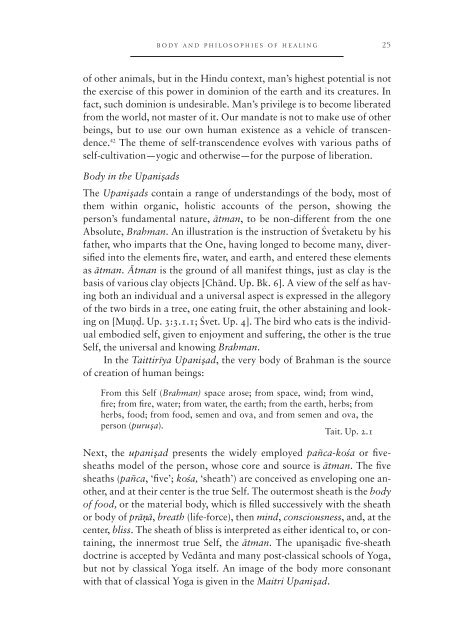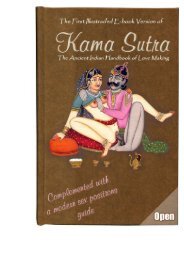body and health in yoga, Ayurveda, and Tantra
body and health in yoga, Ayurveda, and Tantra
body and health in yoga, Ayurveda, and Tantra
Create successful ePaper yourself
Turn your PDF publications into a flip-book with our unique Google optimized e-Paper software.
ody <strong>and</strong> philosophies of heal<strong>in</strong>g 25<br />
of other animals, but <strong>in</strong> the H<strong>in</strong>du context, man’s highest potential is not<br />
the exercise of this power <strong>in</strong> dom<strong>in</strong>ion of the earth <strong>and</strong> its creatures. In<br />
fact, such dom<strong>in</strong>ion is undesirable. Man’s privilege is to become liberated<br />
from the world, not master of it. Our m<strong>and</strong>ate is not to make use of other<br />
be<strong>in</strong>gs, but to use our own human existence as a vehicle of transcendence.<br />
42 The theme of self-transcendence evolves with various paths of<br />
self-cultivation—yogic <strong>and</strong> otherwise—for the purpose of liberation.<br />
Body <strong>in</strong> the UpaniÓsads<br />
The UpaniÓsads conta<strong>in</strong> a range of underst<strong>and</strong><strong>in</strong>gs of the <strong>body</strong>, most of<br />
them with<strong>in</strong> organic, holistic accounts of the person, show<strong>in</strong>g the<br />
person’s fundamental nature, ātman, to be non-different from the one<br />
Absolute, Brahman. An illustration is the <strong>in</strong>struction of Ívetaketu by his<br />
father, who imparts that the One, hav<strong>in</strong>g longed to become many, diversified<br />
<strong>in</strong>to the elements fire, water, <strong>and</strong> earth, <strong>and</strong> entered these elements<br />
as ātman. Åtman is the ground of all manifest th<strong>in</strong>gs, just as clay is the<br />
basis of various clay objects [Ch¯<strong>and</strong>. Up. Bk. 6]. A view of the self as hav<strong>in</strong>g<br />
both an <strong>in</strong>dividual <strong>and</strong> a universal aspect is expressed <strong>in</strong> the allegory<br />
of the two birds <strong>in</strong> a tree, one eat<strong>in</strong>g fruit, the other absta<strong>in</strong><strong>in</strong>g <strong>and</strong> look<strong>in</strong>g<br />
on [MuÓnÓd. Up. 3:3.1.1; Ívet. Up. 4]. The bird who eats is the <strong>in</strong>dividual<br />
embodied self, given to enjoyment <strong>and</strong> suffer<strong>in</strong>g, the other is the true<br />
Self, the universal <strong>and</strong> know<strong>in</strong>g Brahman.<br />
In the Taittir¯ıya UpaniÓsad, the very <strong>body</strong> of Brahman is the source<br />
of creation of human be<strong>in</strong>gs:<br />
From this Self (Brahman) space arose; from space, w<strong>in</strong>d; from w<strong>in</strong>d,<br />
fire; from fire, water; from water, the earth; from the earth, herbs; from<br />
herbs, food; from food, semen <strong>and</strong> ova, <strong>and</strong> from semen <strong>and</strong> ova, the<br />
person (puruÓsa).<br />
Tait. Up. 2.1<br />
Next, the upaniÓsad presents the widely employed pañca-ko´sa or fivesheaths<br />
model of the person, whose core <strong>and</strong> source is ātman. The five<br />
sheaths (pañca, ‘five’; ko´sa, ‘sheath’) are conceived as envelop<strong>in</strong>g one another,<br />
<strong>and</strong> at their center is the true Self. The outermost sheath is the <strong>body</strong><br />
of food, or the material <strong>body</strong>, which is filled successively with the sheath<br />
or <strong>body</strong> of prāÓnā, breath (life-force), then m<strong>in</strong>d, consciousness, <strong>and</strong>, at the<br />
center, bliss. The sheath of bliss is <strong>in</strong>terpreted as either identical to, or conta<strong>in</strong><strong>in</strong>g,<br />
the <strong>in</strong>nermost true Self, the ātman. The upaniÓsadic five-sheath<br />
doctr<strong>in</strong>e is accepted by Ved¯anta <strong>and</strong> many post-classical schools of Yoga,<br />
but not by classical Yoga itself. An image of the <strong>body</strong> more consonant<br />
with that of classical Yoga is given <strong>in</strong> the Maitri UpaniÓsad.



